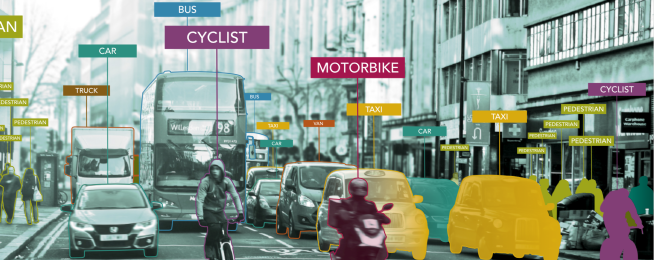In a first Transport for London is using artificial intelligence to to analyse video feeds and count bikes and pedestrians in real time.
The trial has produced a remarkable 98% accuracy.
Until now TfL, like many transport authorities, has relied mainly on manual traffic counts to work out how many people are cycling on any given road.
Counting helps assess demand for new cycle routes and helps improve the planning and operation the road network for the growing numbers of people riding bikes
Manual traffic counts are usually carried out at limited locations and are only able to give a snapshot of road use on the given day or time.
Even where 24 hour traditional camera counts are used, the video has to be sent away for humans to analyse, taking weeks.
Transport for London (TfL) is working with Vivacity Labs, an innovative London tech firm on the trial.
The Vivacity sensors use artificial intelligence to detect road users and decide which mode of transport they are using.
The sensors gather data around the clock, which provides a significantly more detailed picture of how London's roads are being used by everyone 24/7.
All video captured by the sensors is processed and discarded within seconds, meaning that no personal data is ever stored.
TfL is in the process of introducing 43 more Vivacity sensors at 20 central London locations to gather data and further test to understand the full range of capabilities the technology has to offer.
"Data about the numbers of people cycling is a vital part of TfL's planning for new cycleways across London,” TfL says.
“As the network continues to grow, TfL will use data from sources such as the sensors to work out where investment in new infrastructure can best be targeted.
"Enabling more people to walk and cycle is central to the Mayor's efforts to tackle London's toxic air, ill-health and the climate emergency.”
The Mayor's Transport Strategy target is for 80 per cent of journeys in London made by walking, cycling and public transport by 2041.
As well as accurately detecting people cycling, the sensors also detect people walking and other types of traffic, including cars, HGVs, vans, motorcyclists and buses.
This will lead to a much better understanding of demand on the road network and how TfL can balance it.
London's Walking and Cycling Commissioner, Will Norman, said: "By getting more people cycling and walking, we can help to tackle congestion and pollution in London and improve our health. Our Healthy Streets approach is based on evidence and data and we welcome new technology that supports this.”
TfL has not said whether the technology can identify gender. That would be a real breakthrough as the proportion of females on a bike route is a good general indicator of its attractiveness.
Become our friend
Find out more about Bicycle Network and support us in making it easier for people to ride bikes.


